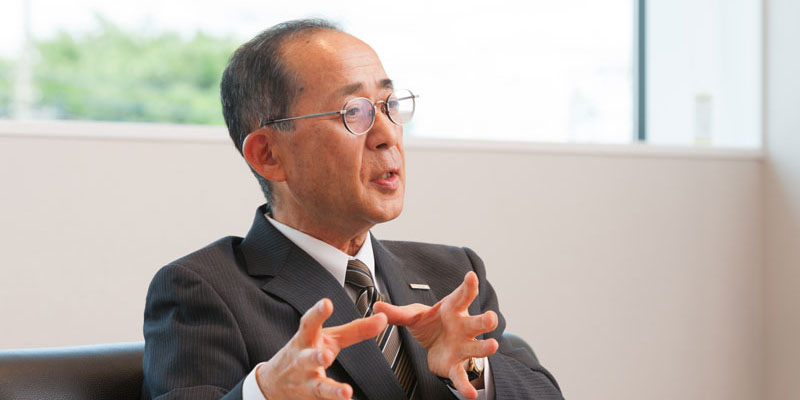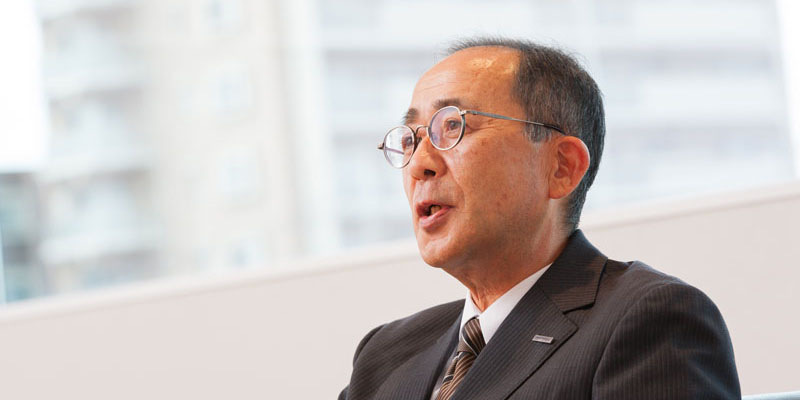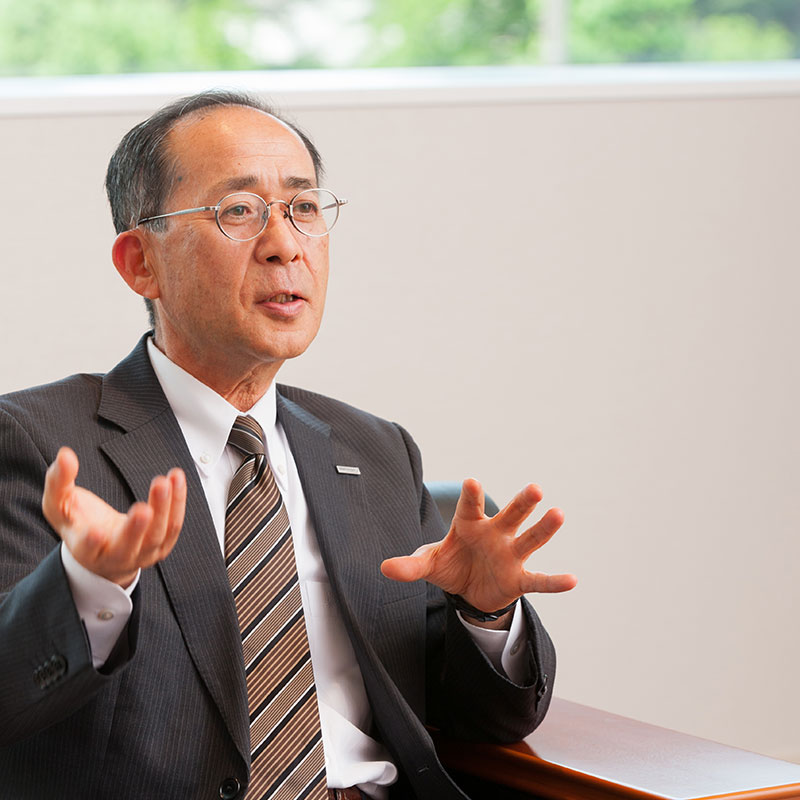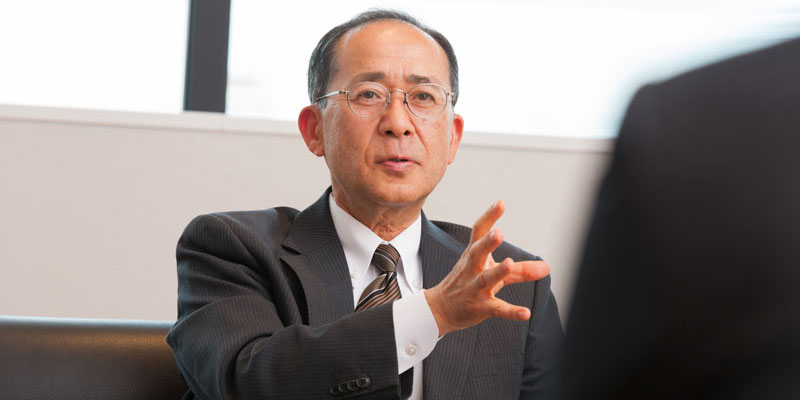Strategy
Interview with the President
We will build on business structure reforms to increase corporate value through innovation born from synergies between a new development culture and our core technologies.
Yoshinori Suzuki
President

Vision & Strategy
-
QPlease tell us about the business structure reforms announced in November 2020 and their progress so far.
AThe business structure reforms seek to transform Shindengen to be resilient against fluctuations in the market environment.
-
Several factors led up to these business structure reforms, including the slowing of the Electronic Device Business due to prolonged trade friction between the United States and China and decreased demand due to lockdowns around the world caused by the COVID-19 pandemic. The Car Electronics Business, Shindengen’s strongest earner, also saw a major decline in revenue, mainly in Southeast Asia. The goals of these business structure reforms are thus to overhaul our revenue structure, which has been susceptible to changes in the market environment, and to build a robust management foundation.
We are implementing four specific policies: Reorganizing the development framework, revising production systems, rationalizing unprofitable products, and adjusting staffing levels. Under the first, reorganizing the development framework, we have concentrated our development departments at the Asaka Office (opened in April 2021) to proactively advance synergies in product development.
The second is revising production systems. To significantly increase the utilization rate of semiconductor front-end processing clean rooms while decreasing maintenance costs, we have integrated functions, moving from five to three domestic facilities. In addition, to increase our market share in power modules by reinforcing competitiveness, we moved some of our domestic production lines to Lamphun, Thailand.
Under the third, rationalizing unprofitable products, we made changes to, for example, our lineup of power conditioners in the Energy Systems & Solutions Business. These products used to enjoy strong demand, because they offer high performance and help reduce carbon emissions. However, in light of falling demand in recent years, we decided to phase out production of power conditioners. In addition, we have announced price increases and production halts for some semiconductor products, which have seen rising costs alongside a shift toward high-variety, low-volume production.
In implementing the fourth measure, adjusting staffing levels, we had to let go of a total of 165 employees from the Company and the domestic Group.
We expect these four measures to increase profit in fiscal 2021 by approximately ¥3.6 billion.
For more information about
Business structure reforms, please see Our Business Strategy.
Performance
-
QPlease tell us about Shindengen’s fiscal 2020 results.
AEach segment is in the middle of changes aimed at enabling stable earnings generation.
-

In fiscal 2020, the year ended March 31, 2021, the Shindengen Group recorded a net loss for a second consecutive year, with a net loss per share of ¥539.73, significantly impacting shareholder value. As I mentioned at the top, U.S.-China trade friction and the COVID-19 pandemic have thrown into sharp relief the susceptibility of our revenue structure to changes in the market environment, and I offer my deepest apologies to our shareholders and other stakeholders for this outcome. It should be noted that the fiscal 2020 net loss included ¥3.9 billion in business structure reform expenses, and I think we can expect to see major improvement in revenue and profit going forward.
Semiconductor demand made a strong recovery in the latter half of the fiscal year, mainly in the automobile and consumer electronics markets. In the Electronic Device Business, although net sales were slightly below ¥30 billion, due to efforts to reduce expenses and the cost of sales, we were able to return operating income to the black, albeit just. In fiscal 2021, we are seeing the temporary emergence of certain risk factors, such as rising copper prices and resin supply limitations, but we do not expect a significant decline in demand.
In the Car Electronics segment, the COVID-19 pandemic forced us to suspend operations for about a month in India and Indonesia, but results recovered to about 80% of the pre-pandemic levels of two years ago. The recovery of the motorcycle market will depend in large part on a recovery in the incomes of the consumers that buy motorcycles, and a complete recovery may take several years. In fiscal 2021, the COVID-19 pandemic will continue to have an impact, but the market is expected to gradually improve.
In the energy system business of the Other segment, we are moving toward profitability, reflecting increasing installations of 5G mobile base stations and the end of production of unprofitable products.
For more information about
Business performance, please refer to Management’s Discussion and Analysis.
-
QPlease tell us about the progress of the Medium Term Business Plan (Fiscal 2019–2021).
ALeveraging our core technologies, we worked to increase added value, expand our power module lineup and develop next-generation products.
-

Enhance the competitiveness of mainstay products
To expand and maintain the market share of our mainstay products, we worked to increase added value. In semiconductors, we expanded our lineup of products that meet the AEC-Q101 reliability standard for electronic components used in automobiles in an effort to grow our market share in the automobile market.
In the motorcycle market, we introduced ECUs that comply with exhaust regulations that came into effect in India in April 2020 (Bharat stage 6 emission standards, known as BS6). Reflecting a growing focus not only on price, but also on technological capabilities to meet environmental regulations, we made major strides forward, including delivering products for the first time to two domestic manufacturers in India.
Develop growth businesses
In power modules, which bring together many of our core technologies, we worked to enhance our lineup of small, lightweight products and expand sales in the mobility and industrial machinery market. We aim to increase the portion of sales in the Electronic Device Business attributable to power modules from the current level of approximately 10% to around 20% by fiscal 2024. Inquiries for power modules have been extremely strong, and we are proactively working to expand sales using online conferencing and other tools in light of restrictions on international travel due to the COVID-19 pandemic.
We advanced development of DC/DC converters for automobiles and power control units (PCUs) for electric motorcycles. Furthermore, in anticipation of the full-fledged arrival of the EV era, we developed a 150kW EV quick charger, a first among Japanese manufacturers. This product is drawing growing attention, and we will strive to expand sales going forward.
Create next-generation products that are a decade ahead
In June 2021, the Future Product Development (FPD) department was established in a bottom-up manner. Since the start of the current Medium Term Business Plan, the Future Strategy Committee, which brought together junior and mid-level engineers from across the Group’s businesses, discussed ideas for next-generation products. The FPD Department is the next iteration of these efforts and will advance the development of products that will contribute to society in the future.
In addition, we are advancing the development of next-generation power devices, including those using gallium oxide, and wireless chargers for EVs.
Based on these measures, for fiscal 2021 we forecast net sales of ¥87,900 million, operating income of ¥4,100 million and profit attributable to owners of parent of ¥3,900 million. Net income per share is forecast at ¥378.47.
For more information about
The Medium Term Business Plan, please refer to Basic Strategy.Forecasts of fiscal 2021 results are as of May 12, 2021.
Governance
-
QPlease tell us your thoughts on governance and returning profits to shareholders.
AWe have reinforced governance by seating a woman on our Audit & Supervisory Board and continue to invest in growth, aiming to increase corporate value and return profits to shareholders.
-

During the COVID-19 pandemic, the Shindengen Group’s Board of Directors shifted to regularly holding meetings online, enabling participation without the need to meet in person. Amid this new format, through a third-party institution, we once again carried out the annual survey of all directors and Audit & Supervisory Board members regarding the effectiveness of the Board of Directors and analyzed the results. Such efforts to gather explicit data have helped to improve effectiveness, and the evaluations are improving year by year. The result of this year’s evaluation found that the board generally secured effectiveness.
In addition, we welcomed our first female Audit & Supervisory Board member and reinforced our governance system by increasing the number of Audit & Supervisory Board members to four. Diversity on the Board of Directors, including that of gender and nationality, remains under consideration.
We position returning profits to shareholders as an important management issue. Our basic policy is to maintain and reinforce industry competitiveness by distributing profits based on comprehensive consideration of such factors as retained earnings, ROE and performance forecasts.
As I previously mentioned, we recorded a net loss for a second consecutive year in fiscal 2020. We have, as in the previous fiscal year, reduced executive compensation.
I regret to say that we have decided not to pay shareholder dividends this year, per resolution of the general meeting of shareholders. Nevertheless, in light of the bright future of Shindengen’s businesses environment over the medium and long terms, we do not plan to make major cuts to capital investment and R&D investment. We will continue to invest in growth. Given this, we plan to pay a per-share dividend of ¥100 for fiscal 2021.
For more information about
The corporate governance system, please refer to Corporate Governance.
Environment & Social
-
QCould you tell us about the Shindengen Group’s initiatives to help achieve the Sustainable Development Goals?
AThrough product development in line with our corporate mission, we are contributing to the achievement of the sustainable development goals.
-

The Shindengen Group’s corporate mission is “maximizing energy conversion efficiency for the benefit of humanity and society.” We position this mission at the center of our business activities. Initiatives to achieve the Sustainable Development Goals (SDGs) are extremely compatible with our corporate mission. Based on this understanding, as the first stage of our efforts in this area, we have set our sights on target 7.3 of the SDGs, which we see as an extension of our businesses, and are advancing efforts accordingly.
Our main initiatives to this end include the development of DC/DC converters for eco-friendly vehicles and ideal diodes. Both of these help to maximize conversion efficiency and realize low loss. In fiscal 2021, we plan to expand the range of our material issues and move up to the second stage in order to fulfill our responsibilities as a corporate citizen.
For more information about
Eco-friendly products, please refer to Business Segments.
Purpose & Message
-
QDo you have any other message for shareholders and investors?
AThrough synergies between a new development culture and our core technologies, we aim to make Shindengen a company that we can all be proud of, a company that lasts a century by meeting society’s needs.
-
When I took office as president in 2016, I resolved to do my utmost to make Shindengen a company that lasts a century by meeting society’s needs. The Hanno Factory, the Group’s R&D base, had been in operation for 70 years as of 2019 and was facing challenges related to facility aging. Establishing the new Asaka Office to decisively address these issues represents an important investment in our operational foundations to reach the 100-year milestone. Anticipating its use over the long term, the new building is designed to be eco-friendly and offers an enhanced ICT environment and increased meeting spaces, reinforcing and updating the tangible assets underlying our businesses.
At the same time, in terms of intangible assets, which are the key to growth, we are reorienting management toward proactively supporting efforts to take on ambitious challenges, as in the FPD department, in order to foster a new development culture and a new organizational culture. We believe a culture in which employees enjoy their work is indispensable.
The Asaka Office is within commuting distance of central Tokyo, and I am confident that it will appeal to young engineers eager to work at an R&D site. In addition, over the past several years, a growing number of female engineers have joined Shindengen, a positive trend that I hope we can effectively leverage to become a diverse innovation company that lasts a century.
The Shindengen Group, with its core technologies in semiconductors, circuit design and mounting, is extremely unique. At the new Asaka Office, we will accelerate synergies between a new development culture and our core technologies in order to create advanced and unique products that are unrivaled by competitors from the customer’s perspective. By doing so, I believe that Shindengen will become more useful and more essential to society, and better able to contribute to the achievement of the SDGs.
I hope that our shareholders and investors will consider the Shindengen Group’s corporate value from a medium- to long-term perspective and ask for your continued understanding and support.
For more information about
Shindengen’s value creation model, please refer to Value Creation Model.

